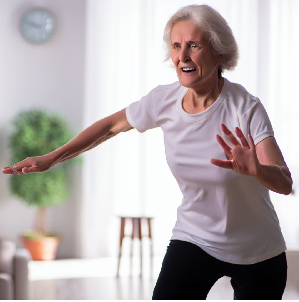Parkinson’s disease, a neurodegenerative disorder that affects millions of individuals worldwide, presents significant challenges to both patients and healthcare professionals. While current treatments focus on managing symptoms, recent research suggests that intense exercise may hold the key to keeping Parkinson at bay. This article explores the potential benefits of intense exercise in preventing and managing Parkinson, shedding light on its positive impact on physical and mental well-being.
Understanding Parkinson’s Disease Parkinson’s Disease
Definition and prevalence of Parkinson’s disease
Parkinson’s disease is a progressive neurological disorder characterized by the loss of dopamine-producing cells in the brain. This loss of dopamine leads to various motor and non-motor symptoms that impact the quality of life of individuals affected by the disease. Common motor symptoms include tremors, bradykinesia (slowness of movement), and rigidity. Non-motor symptoms may include cognitive impairment, depression, sleep disturbances, and autonomic dysfunction.
Understanding the Scope of the Condition
Parkinson is a widespread condition, with a significant impact on individuals and healthcare systems. It affects people of all ethnicities and genders, typically manifesting in individuals over the age of 60. The prevalence of Parkinson’s varies across regions, with higher rates observed in North America and Europe. Research suggests that approximately 1% of individuals above the age of 60 are affected by Parkinson’s disease, making it one of the most prevalent neurodegenerative disorders.
An Overview of Parkinson’s Symptoms
Parkinson presents a range of symptoms that affect both motor and non-motor functions. Motor symptoms include tremors, which are often the hallmark of the disease, as well as bradykinesia (slowness of movement), rigidity, and postural instability. Non-motor symptoms encompass cognitive impairment, depression, anxiety, sleep disturbances, and autonomic dysfunction.
Impact on Daily Life
Parkinson’s has a profound impact on daily life, affecting various aspects of an individual’s physical, emotional, and social well-being. Motor symptoms can impair mobility, making simple tasks like walking, writing, or getting dressed challenging. Fine motor skills may deteriorate, leading to difficulties with tasks that require dexterity, such as buttoning clothes or using utensils
Parkinson’s can also cause emotional and cognitive changes, such as depression, anxiety, and memory problems. These changes may affect relationships, work productivity, and overall quality of life. Additionally, non-motor symptoms, including sleep disturbances and autonomic dysfunction, can disrupt sleep patterns, digestion, and blood pressure regulation, further impacting daily functioning.
Role of Exercise in Parkinson’s Disease Management
Exercise plays a crucial role in managing Parkinson’s disease, a neurodegenerative disorder that affects millions of individuals worldwide. This article aims to shed light on the significance of exercise in the management of Parkinson. By exploring the benefits, types, and considerations, we aim to empower individuals with Parkinson’s disease to incorporate exercise into their daily routines for improved well-being.
Understanding the Benefits of Exercise
Exercise offers a range of benefits for individuals with Parkinson’s disease. It can improve motor symptoms, enhance balance and coordination, boost cardiovascular fitness, and strengthen muscles. Regular exercise has also been linked to better cognitive function, reduced depression and anxiety, and overall improvement in quality of life.
Types of Exercise for Parkinson Management
Before starting an exercise regimen, individuals with Parkinson’s disease must consult healthcare professionals. They can provide personalized recommendations, considering the severity of symptoms, overall health, and individual capabilities. Healthcare professionals can also help tailor exercise programs to address specific needs and goals, ensuring safety and effectiveness.
Aerobic Exercise for Parkinson’s Disease

Engaging in aerobic exercises such as walking, jogging, swimming, or cycling improves cardiovascular health, enhances endurance, and increases overall fitness levels. These activities stimulate the release of endorphins, promoting a positive mood and reducing the risk of depression.
Strength Training for Parkinson’s Disease
Incorporating strength training exercises into a routine helps maintain muscle strength, improve muscle tone, and counteract the stiffness that often accompanies Parkinson. Resistance bands, free weights, or weight machines can be utilized to target specific muscle groups.
Balance and Flexibility Exercises for Parkinson’s Disease
Practicing balance and flexibility exercises, such as yoga, tai chi, or Pilates, can significantly improve stability, posture, and range of motion. These exercises focus on strengthening core muscles, enhancing coordination, and reducing the risk of falls.
Coordination and Agility Exercises for Parkinson’s Disease
Exercises that target coordination and agility, such as dancing, boxing, or obstacle courses, challenge the body and mind. These activities improve motor skills, promote quick reflexes, and boost confidence in movement and balance.
Mind-Body Exercises for Parkinson’s Disease
Mind-body exercises, including yoga, tai chi, or meditation, emphasize the connection between the mind and body. These practices promote relaxation, reduce stress, enhance body awareness, and improve overall mental well-being.
Adapted and Therapeutic Exercises for Parkinson’s Disease
Adapted exercises, such as seated exercises or modified equipment, accommodate individuals with limited mobility or physical challenges. Therapeutic approaches, including physical therapy or occupational therapy, provide personalized exercise plans to address specific needs and optimize functional abilities.
Takeaway
Incorporating various types of exercise into a Parkinson’s disease management plan can have significant benefits for individuals living with the condition. Aerobic exercise improves cardiovascular fitness, strength training enhances muscular strength and reduces stiffness, balance, and flexibility exercises enhance stability, coordination, and agility exercises promote motor skills and confidence, mind-body exercises nurture physical and mental well-being and adapted or therapeutic approaches tailor exercises to individual needs. By embracing these exercise modalities, individuals with Parkinson can enhance their overall quality of life, manage symptoms, and foster physical and mental well-being. Regular exercise is always works best and improves your health and physical ability.




